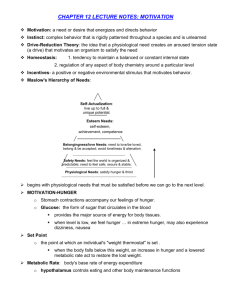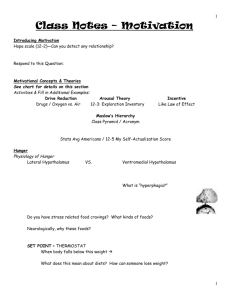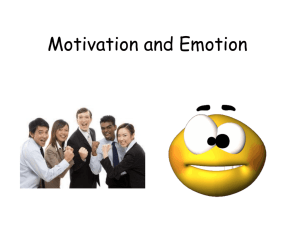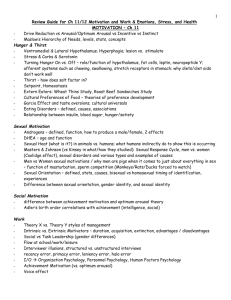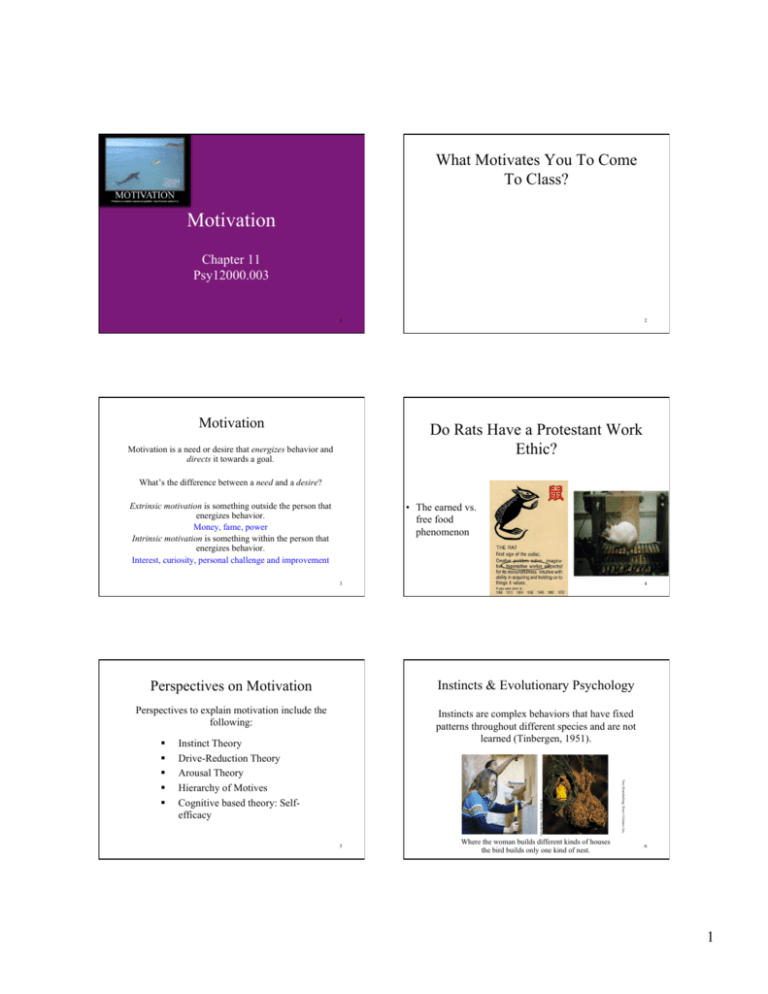
What Motivates You To Come
To Class?
Motivation
Chapter 11
Psy12000.003
1
Motivation
2
Do Rats Have a Protestant Work
Ethic?
Motivation is a need or desire that energizes behavior and
directs it towards a goal.
What’s the difference between a need and a desire?
Extrinsic motivation is something outside the person that
energizes behavior.
Money, fame, power
Intrinsic motivation is something within the person that
energizes behavior.
Interest, curiosity, personal challenge and improvement
• The earned vs.
free food
phenomenon
3
4
Perspectives on Motivation
Instincts & Evolutionary Psychology
Perspectives to explain motivation include the
following:
Instincts are complex behaviors that have fixed
patterns throughout different species and are not
learned (Tinbergen, 1951).
5
Where the woman builds different kinds of houses
the bird builds only one kind of nest.
Tony Brandenburg/ Bruce Coleman, Inc.
Instinct Theory
Drive-Reduction Theory
Arousal Theory
Hierarchy of Motives
Cognitive based theory: Selfefficacy
© Ariel Skelley/ Masterfile
6
1
Drive-Reduction Theory
Drive Reduction
When the instinct theory of motivation failed to
explain most human motivation, it was replaced by
the drive-reduction theory. A physiological need
creates an aroused tension state (a drive) that
motivates an organism to satisfy the need (Hull,
1951).
The physiological aim of drive reduction is
homeostasis, the maintenance of a steady internal state
(e.g., maintenance of steady body temperature).
Drive
Reduction
Food
Empty
Stomach
Stomach
Full
(Food Deprived)
7
Incentive
8
Organism
Question
Where our needs push, incentives (positive or negative
stimuli) pull us in reducing our drives.
Henry Murray called these needs and presses.
A food-deprived person (n Hunger) who smells baking bread
(incentive) (p Food) feels a strong hunger drive.
• What need would
explain why we seek
thrills, excitement?
• Why do we like scary
movies?
• What drives are being
reduced by going on a
roller coaster or
parachuting?
9
Optimum Arousal
10
Hierarchy of Needs
Human motivation aims to seek optimum levels of
arousal, not to eliminate it. Young monkeys and
children are known to explore the environment in the
absence of a need-based drive.
Randy Faris/ Corbis
Harlow Primate Laboratory, University of Wisconsin
Abraham Maslow (1970)
suggested that certain needs
have priority over others.
Physiological needs like
breathing, thirst, and
hunger come before
psychological needs such as
achievement, self-esteem,
and the need for
recognition.
(1908-1970)
11
12
2
Maslow’s Hierarchy of Needs
Self-Efficacy-Bandura
Joe Skipper/ Reuters/ Corbis
Mario Tama/ Getty Images
David Portnoy/ Getty Images for Stern
Menahem Kahana/ AFP/ Getty Images
Hurricane Survivors
13
• A belief (cognitive component of theory) in
one’s abilities to succeed
• A sense of control over one’s environment
(social, work, etc.)
• Self-efficacy can be strengthened with clear
goals, social modeling, feedback, and
challenges to current ability levels.
• On YouTube, there are many short videos
about self-efficacy.
14
Classic Positions on Motivation
Specific Motivations
• Freud
•
•
•
•
•
•
– Id
– Ego
– Superego
• Skinner
– Reinforcement
• Humanistic (Maslow, Rogers)
– Self-actualization
Social
Control
Hunger
Sex
Belonging
Work
15
16
Social Motivation
• Others’ opinions and evaluations of
self contribute to a strong motivating
system
• Social Facilitation, Social Loafing
• Self-monitoring
• Fame
Coactive or Evaluative
Presence of Others
⇑Arousal
– Being known, recognized may supersede
being liked
⇑ likelihood
of dominant response
⇑ performance on
easy, well-learned tasks
⇓ performance on
difficult, poorly learned tasks
But, why?
• Jerry Springer’s guests?
• Conformity
(1) Compresence (Zajonc, 1966)
– Fitting in = Being liked
– Avoiding rejection/exclusion
(2) Evaluation apprehension (Cottrell, 1968)
• Social motivation contributes to what and how much we eat, whether
or not we smoke, take drugs, have sex…
(3) Distraction-conflict (Baron & Sanders, 1986)
17
18
3
19
• Reactance
– When you feel that your freedom is being restricted, you will
act in such a way to regain that freedom
• Learned Helplessness
– Upon repeated noncontingencies between one’s behaviors
and one’s outcomes (and after initial reactance), learned
helplessness occurs
• Uncontrolled negative outcomes more likely to cause LH than
uncontrolled positive outcomes
– But see Self-handicapping
Giving up
Pessimism
Depression
Learned Helplessness Tutorial
20
Hunger
Control Motivation
•
•
•
•
Latané, Williams, & Harkins (1979)
21
• When do we eat?
• Why do we like certain foods and
not others?
• Why do we eat too much?
• Why do our emotions affect our eating?
An obvious answer to “When do we eat?” is “When are we
hungry.” Turns out, that’s only part of the answer.
But, how do we know when we are hungry?
When there is no food in our stomach.
How do we know when our stomach is empty?
Our stomach growls. These are also called hunger pangs.
22
The Physiology of Hunger
Yet….Stomachs Removed
Stomach contractions (pangs) send signals to the
brain making us aware of our hunger.
Tsang (1938) removed rat stomachs, connected the
esophagus to the small intestines, and the rats still felt
hungry (and ate food).
23
In other words, no
hunger pangs were possible…
yet eating persisted
24
4
The Importance of Glucose: C6H12O6
Increases in insulin (a hormone affecting pancreas,
liver, muscle, and fat tissue) decreases glucose in the
blood.
Decreased glucose makes us feel hungry.
Insulin also affects
brain: improves
verbal memory
Glucose Molecule
Glucose & the Brain
Levels of glucose in the
blood are monitored by
receptors (neurons) in the
stomach, liver, and
intestines. They send
signals to the
hypothalamus in the
brain.
Rat Hypothalamus
25
Hypothalamic Centers
26
Hypothalamic Centers
The lateral hypothalamus (LH)
brings on hunger (stimulation).
The ventromedial hypothalamus (VMH) depresses
hunger (when stimulated).
Destroy the LH, and the animal
has no interest in eating.
With the LH intact, the reduction of blood glucose leads
rats to eat ravenously.
If you destroy the VMH, the animal eats excessively.
27
Hypothalamus & Hormones
Hormone
Tissue
Set-Point Theory
Manipulating the lateral and the ventromedial
hypothalamus alters the body’s “weight thermostat.”
Response
Orexin increase
Hypothalamus
Increases hunger
Ghrelin increase
Stomach
Increases hunger
Insulin increase
Pancreas
Increases hunger
Leptin increase
Fat cells
Decreases hunger
PPY increase
Digestive tract
Decreases hunger
The hypothalamus monitors a number of hormones that
are related to hunger.
28
29
If weight is lost, food intake increases and energy expenditure
decreases. If weight is gained, the opposite takes place.
30
5
The Psychology of Hunger
Social Factors
Memory plays an important role in hunger.
When did I eat last?
Due to difficulties with retention, amnesia patients
eat frequently if given food (Rozin et al., 1998).
Schachter found that manipulating a
clock on the wall influenced reports
of hunger, and willingness to eat.
31
• We eat when others eat whether we are hungry or
not; we tend not to like eating alone (especially
females)
• Females eat less with a male than they eat with a
female. (Males are unaffected)
• Current investigation here at
Purdue examining whether
fat rats will regulate their
intake when in the presence
of skinny rats.
32
Taste Preference: Biology or Culture?
Hot Cultures like Hot Spices
Body chemistry and environmental factors influence not only
when we feel hunger but what we feel hungry for!
Fullness doesn’t necessarily mean you don’t want to eat anything
else. It often means, “I am tired of that particular taste.”
Countries with hot climates use more bacteriainhibiting spices in meat dishes.
Victor Englebert
Richard Olsenius/ Black Star
33
Eating Disorders
Anorexia Nervosa: A condition in which a normalweight person (usually an adolescent woman)
continuously loses weight but still feels overweight.
34
Is the Relationship between Eating
and Weight Gain That Simple?
Lisa O’Connor/ Zuma/ Corbis
Reprinted by permission of The New England
Journal of Medicine, 207, (Oct 5, 1932), 613-617.
35
36
6
Eating Disorders
Obesity
A disorder characterized by being excessively
overweight. Obesity increases the risk for health
issues like cardiovascular diseases, diabetes,
hypertension, arthritis, and back problems.
http://www.cyberdiet.com
Bulimia Nervosa: A
disorder characterized
by episodes of
overeating, usually
high-calorie foods,
followed by vomiting,
using laxatives, fasting,
or excessive exercise.
37
Reasons for Eating Disorders
38
Body Image (Women)
Sexual Abuse Myth: Childhood sexual abuse
does not cause eating disorders.
Family: Younger generations develop eating
disorders when raised in families in which
weight is an excessive concern.
Genetics: Twin studies show that eating disorders
are more likely to occur in identical twins rather
than fraternal twins.
Social: Advertising/peer pressure/norms.
Western culture tends to place more emphasis on a
thin body image in comparison to other cultures.
39
Summary
40
Sexual Motivation
41
42
7
Waist-to-hip ratio
Sexual Motivation
Why are we sexually attracted to certain others?
What, specifically, is motivating about sex?
Sexual motivation is nature’s clever way of making
people procreate, enabling our species to survive.
• Interestingly, despite variations in cultures
and eras for women’s weight, men have
always preferred
women as mates who
have roughly the same
waist-to-hip ratio.
– The ideal ratio for women is considered to be
about 0.7
– Devendra Singh’s (1993) research
43
44
The Physiology of Sex
Sexual Problems
Masters and Johnson (1966) describe the human
sexual response to consist of four phases:
Men generally suffer from two kinds of sexual
problems: premature ejaculation and erectile
disorder. Women may suffer from orgasmic
disorders.
Phase
Physiological Response
Excitement
Genitals become engorged with blood. Vagina expands
secretes lubricant. Penis enlarges.
Plateau
Excitement peaks such as breathing, pulse and blood
pressure.
Orgasm
Contractions all over the body. Increase in breathing,
pulse & blood pressure. Sexual release.
Resolution
Engorged genital release blood. Male goes through
refractory phase. Women resolve slower.
These problems are not due to personality disorders and can
be treated through behavior therapy and drugs such as Viagra.
45
46
Hormones and Sexual Behavior
Testosterone
Sex hormones effect the development of sexual
characteristics and (especially in animals) activate
sexual behavior.
Levels of testosterone remain relatively constant in
males, so it is difficult to manipulate and activate
sexual behavior. Castration, which reduces
testosterone levels, lowers sexual interest.
Testosterone
Male
Female
Testes
Ovaries
Adrenals
(Small amounts of
estrogen)
Estrogen
(Small amounts of
testosterone)
47
48
8
Estrogen
The Psychology of Sex
Female animals “in heat” express peak levels of
estrogen. Female receptivity may be heightened with
estrogen injections.
Hunger responds to a need. If we do not eat, we die.
In that sense, sex is not a need because if we do not
have sex, we do not die.
Sex hormones may have milder affects on humans than on
animals. Women are more likely to have sex when close to
ovulation (increased testosterone), and men show increased
testosterone levels when socializing with women.
A need for
species-survival?
49
50
External Stimuli
What is motivating about sex?
It is common knowledge that men become sexually
aroused when browsing through erotic material.
However, women experience similar heightened
arousal under controlled conditions.
• The physiological pleasure derived
from orgasm?
– If that’s it, why not be satisfied with
masturbation?
51
52
Dreams
Our imagination in our brain can influence sexual
arousal and desire. People with spinal cord injuries
and no genital sensation can still feel sexual desire.
Dreams, another form of imagination, are also
associated with sexual arousal. Genital arousal is
associated with all kinds of dreams. Nearly all men
and 40% of women who dream of sexual imagery end
up with an orgasm (Wells, 1986).
Sotographs/The Gamma-Liaison Network/ Getty Images
Imagined Stimuli
53
54
9
Adolescent Sexuality
Contraception
When individuals reach adolescence, their sexual
behavior develops. However, there are cultural
differences.
Sexual promiscuity in modern Western culture is much
greater than in Arab countries and other Asian countries.
Ignorance: Canadian teen girls do not have the right
ideas about birth control methods.
Guilt Related to Sexual Activity: Guilt reduces sexual
activity, but it also reduces the use of contraceptives.
Minimal Communication: Many teenagers feel
uncomfortable about discussing contraceptives.
Alcohol Use: Those who use alcohol prior to sex are less
likely to use contraceptives.
Mass Media: The media’s portrayal of unsafe
extramarital sex decreases the use of contraceptives.
55
Sexually Transmitted Infections
Sexual Orientation
Correlational studies reveal factors that reduce
sexual activity in teens.
56
High Intelligence: Teens with higher intelligence are
likely to delay sex.
Religiosity: Religious teens and adults often reserve sex
for a marital commitment.
Father Presence: A father’s absence from home can
contribute to higher teen sexual activity.
Learning Programs: Teens who volunteer and tutor in
programs dedicated to reducing teen pregnancy are less
likely to engage in unsafe sex.
Sexual orientation refers to a person’s preference for
emotional and sexual relationships with individuals of
the same sex, the other sex, and/or either sex.
Homosexual
Heterosexual
Bisexual
57
58
Sexual Orientation Statistics
Origins of Sexual Orientation
In Europe and America, based on many national
surveys, homosexuality in men is 3-4% and in women
is 1-2%.
Homosexuality is more likely based on biological
factors like differing brain centers, genetics, and
parental hormone exposure rather than environmental
factors.
Cynthia Johnson/ Time magazine
As members of a minority, homosexuals often struggle with
their sexual orientation.
59
Homosexual parents
60
10
Animal Homosexuality
The Brain
In homosexual men, the size of the anterior
hypothalamus is smaller (LeVay, 1991) and the
anterior commissure is larger (Allen & Gorski, 1992).
Again, this is correlational.
A number of animal
species are devoted to
same-sex partners,
suggesting that
homosexuality exists in
the animal world.
Anterior
Commissure
http://www.msu.edu
David Hecker/ AFP/ Getty Images
Wendell and Cass
Anterior
Hypothalamus
61
62
Genes & Sexual Orientation
Hormones & Sexual Orientation
A number of reasons suggest that homosexuality may
be due to genetic factors.
Prenatal hormones affect sexual orientation during
critical periods of fetal development.
Family: Homosexuality seems to run in families.
Twin studies: Homosexuality is more common in
identical twins than fraternal twins. However, there are
mixed results.
Fruit flies: Genetic engineers can genetically manipulate
females to act like males during courtship and males to
act like females.
63
Animals: Exposure of a fetus to testosterone results in
females (sheep) exhibiting homosexual behavior.
Humans: Exposure of a male or female fetus to female
hormones results in an attraction to males.
Heterosexual
male
Homosexual
Heterosexual
female
64
Changing Attitudes
Sexual Orientation: Biology
65
66
11
Sex and Human Values
The Need to Belong
“Promiscuous recreational sex poses certain
psychological, social, health, and moral problems
that must be faced realistically” (Baumrind, 1982).
“[Man] is a social animal,” (Aristotle). Separation
from others increases our need to belong.
20th Century Fox/ Dreamworks/ The Kobal Collection
Andreanna Seymore/ Getty Images
“Cast Away,” Tom Hanks, suffers
from social starvation.
67
Aiding Survival
Belongingness
Social bonds boosted our ancestors’ survival rates.
These bonds led to the following:
68
Protecting against predators, especially for the young.
Procuring food.
Reproducing the next offspring.
Wanting to Belong: The need to belong influences our
thinking and emotions.
Social Acceptance: A sense of belonging with others
increases our self-esteem. Social exclusion decreases it.
Maintaining Relationships: We resist breaking social
bonds, even bad ones.
Exclusion: Social exclusion leads to demoralization,
depression, and when reinclusion seems unlikely, nasty
behavior.
Fortifying Health: People who tend to have close friends
are happier and healthier.
69
70
Motivation at Work
Attitudes Towards Work
The healthy life, said Sigmund Freud, is filled by
love and work.
People have different attitudes toward work. Some
take it as a:
Job: Necessary way to make money.
Career: Opportunity to advance from one position to
another.
Calling: Fulfilling a socially useful activity.
Culver Pictures
71
72
12
Flow & Rewards
Work and Satisfaction
Flow is the experience between no work and a lot of
work. Flow marks immersion into one’s work.
In industrialized countries work and satisfaction go
hand-in-hand.
(Mihaly Csikszentmihalyi, 1990)
People who “flow” in their work (artists, dancers, composers
etc.) are driven less by extrinsic rewards (money, praise,
promotion) and more by intrinsic rewards.
73
What are some other
reasons for this
supposed causal
relationship?
74
Personnel Psychology
Industrial-Organizational (I/O)
Psychology
Personnel psychologists assist organizations at
various stages of selecting and assessing employees.
Applies psychological principles to the workplace.
Personnel Psychology: Studies the principles of selecting
and evaluating workers.
Organizational Psychology: Studies how work
environments and management styles influence worker
motivation, satisfaction, and productivity.
75
© CNAC/ MNAM/ Dist. Rèunion des Musées Nationaux/ Art Resource, NY
Henri Matisse
Harnessing Strengths
Interviews & Performance
Identifying people’s strengths (analytical, disciplined,
eager to learn etc.) and matching them to a particular
area of work is the first step toward workplace
effectiveness.
Interviewers are confident in their ability to predict
long-term job performance. However, informal
interviews are less informative than standardized
tests.
77
76
78
13
The Interviewer Illusion
Structured Interview
Interviewers often overrate their discernment.
A formal and disciplined way of gathering
information from the interviewee. Structured
interviews pinpoint strengths (attitudes, behaviors,
knowledge, and skills). The personnel psychologist
may do the following:
Intention vs. Habits: Intensions matter, but long- lasting
habits matter even more.
Successful Employees: Interviewers are more likely to
talk about those employees that turned out successful.
Presumptions about Candidates: Interviewers presume
(wrongly) that what we see (candidate) is what we get.
Preconceptions: An interviewer’s prior knowledge about
the candidate may affect her judgment.
Analyze the job.
Script questions.
Train the interviewer.
79
Personnel Psychologist’s Tasks
80
Appraising Performance
Appraising performance results in two things: 1)
employee retention, and 2) the encouragement of
better performance.
81
82
Organizational Psychology: Motivating
Achievement
Satisfaction & Engagement
Achievement motivation is defined as a desire for
significant accomplishment.
Harter et al., (2002) observed that employee
engagement means that the worker:
Capital-Journal/ David Eulitt/ AP/ Wide World Photos
Ken Heyman/ Woodfin Camp & Associates
Skinner devised a daily discipline schedule
that led him to become the 20th century’s most
influential psychologist.
1. Knows what is expected of
him.
2. Feels the need to work.
3. Feels fulfilled at work.
4. Has opportunities to do his
best.
5. Thinks himself to be a part
of something significant.
Engaged workers are more productive
6. Has opportunities to learn
than non-engaged workers at different stores
and develop.
84
of the same chain.
83
14
Managing Well
Job-Relevant Strengths
Every leader dreams of managing in ways that enhance
people’s satisfaction, engagement, and productivity in
his or her organization.
Effective leaders need to select the right people,
determine their employees’ talents, adjust their work
roles to their talents, and develop their talents and
strengths.
Ezra Shaw/ Getty Images
Larry Brown offers 4-5 positive comments for every negative
comment.
85
86
Challenging Goals
Leadership Style
Specific challenging goals motivate people to reach
higher achievement levels, especially if there is
feedback such as progress reports.
87
Different organizational
demands need different
kinds of leaders. Leadership
varies from a boss-focused
style to a democratic style.
Task Leadership: Involves setting
standards, organizing work, and focusing on goals.
Social Leadership: Involves mediating conflicts and
building high achieving teams.
88
15




